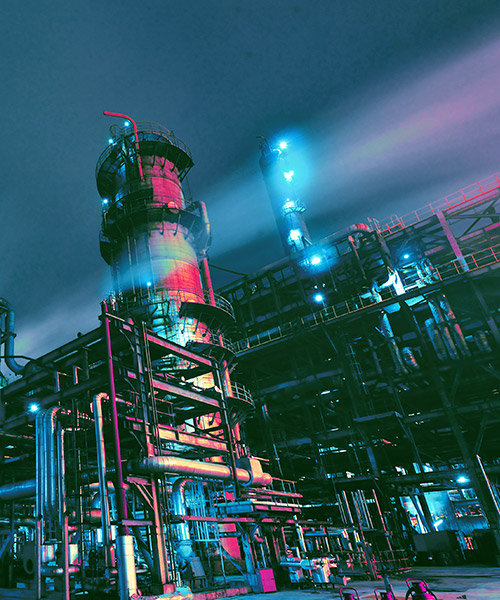December 09, 2021 • 4 min read
What role can digital play in producing sustainable chemicals?
Did you know, by 2050, the global demand for chemicals will be 50 percent higher than in 2020?
“The dual challenge of supplying these chemicals to a growing population – while addressing net zero targets – is complex,” says Chris Mole, Global Technical Director – Hydrocarbons. “And there’s no hiding from the reality that it will take a change in thinking and approach in how assets are developed, delivered, and operated.
Digital is pivotal to success. But where to start?
We asked more than 300 energy, chemical and resources sector operators what they thought were the most important future enablers for achieving their decarbonization strategies, and how they rate their current performance in these areas.
All respondents ranked ‘digital technology’ as the most important enabler. But they also reflected that the application of digital technology presents the largest gap between their ambition and actual performance.
So, while it may be a widely accepted view that data and digitalization are the key to delivering on net zero targets, it’s clear that making this ambition a reality is a challenge.
Many executives have learned that digital transformation is harder to pull off than a typical change program. Frustration, decision paralysis and a failure to capture the value of digital are all too common consequences.
Value-based thinking is needed to capture the value of digital
Digital enablement is already streamlining the engineering process of how we design and deliver large infrastructure. Artificial intelligence and machine learning have an important role in improving the quality of decision making and enabling more autonomous ways of working. And other technologies like blockchain are also disruptive to contracts and supply chain management.
But Paul Hodson, Senior Director, Digital Solutions, believes it will take more than retrofitting different technologies like these into the existing approach and data streams. He believes that a value-based approach is required to maximize the impact that digital technology can bring across the asset’s life.
“Organizations need to consider how and when the right digital technology is introduced to amplify value across all phases of an asset’s life. Not just achieving a small gain within a single phase. We need to change the way we capture, store and use data, and put it in the hands of the right people at the right time to get the most out of it.”
A good example of a lifecycle approach is how a chemical’s carbon footprint, or its greenhouse gas emissions, is measured.
“This is calculated in a lifecycle assessment, which accounts for all the emissions produced, starting from resource extraction and feedstock use through manufacturing to transportation, disposal and reuse or recycle alternatives. Once emissions are calculated, and a baseline is established, efforts can be made to bring those emissions down.”
So, how does this relate to the application of digital technology across the life of the asset?
The value paradox, demonstrated by the digital twin
“I often use the example of how digital twins are commonly implemented in industry to illustrate the value paradox that some organizations can face in digital transformation,” says Hodson.
“The design and build phase of industrial facilities is often regarded as separate from the operational phase. Here, the key motivation is to build a quality facility as quickly and cost effectively as possible. The purpose of digital twins for design and build is often limited to navigation of the asset, simulation of long term production forecast and performance, or support for construction teams.
“However, the greatest benefit of a digital twin is often realized in the operations phase,” Hodson continues. “To improve maintenance strategy and execution, reduce costs, enhance production, and reduce emissions.
“These motivations are very different from those in the design and build phases Yet, realizing these benefits in operations is highly dependent on the level of consideration and implementation of the digital twin in those earlier phases. However, because the return on the investment needed to support effective operations is not realized during the design and build phase, this is often overlooked.
“By the time the operations’ digital twin is implemented, much of the essential data that should be accumulated through design, build and the transition to operation phase, is lost. At best, this extends the time to realize a return on investment. At worst, it makes it impossible to use digital twins effectively in operations at all,” he says.
“It’s not surprising, given the traditional phased approach to asset development and operation. If digital twins are implemented in this way, it can create a narrow business case, restrictive commercial models and financial structures, and a risk of ineffective connectivity and integration across the asset’s value chain.
“The full potential of a digital twin, and digital technology more holistically, is realized when we consider how data will travel across the life of the asset.”
Shift a digital ambition into reality
So, how do we capture the maximum value for the asset, and deliver the most sustainable ways of working?
“To address booming demand for chemicals and fuels, we have an opportunity to change the way we think about the integration of digital technology as new projects come online,” says Mole. “From the earliest phase of a project, we must consider how data will travel across the life of the asset. That means widening our perspective and challenging working practices, commercial models, and interconnectivity and integrations across the value chain.
“This shift in thinking could pave the way to capturing the true value of asset data, enable more efficient operations and help to accelerate emissions reductions in the chemical sector. Only then will we maximize the potential of digital as the enabler of a net zero future.”




